| Part 2 Marrakech |
|
|
The 3rd day, Saturday, November 13.
Perfectly fine.
Got up at 5:40. We stay here at Pickalbatros Hotel tonight, too.
Breakfast of American buffet style.
Left the hotel at 8:30.
The guidebook says Marrakech means the God country in the Berber language.
It is the 3rd largest city in Morocco following Casablanca and Rabat, with
the population of 660.000, in the middle of the country, at an altitude
of 450 meters.
It consists of 2 towns. Medina, an old town surrounded by the castlewalls
of 2 km from east to west and 33 km from north to south, and the new town
widened to the west.
The old town is the largest scale around North Africa, which includes,
Bahia Palace, Elbadie Palace, Saadian Tombs, Berabe Mausoleum and Agudel
Garden, in addition to the Palace.
Marrakech is the 2nd oldest city next to Fez. It was decided to be the
capital by Almoravid dynasty (the 1st Berber Islamic country) approximately
in 1070. Since then until 1269 when the capital was moved to Fez, it was
the center of trade, commerce and learning.
In the middle of 15th century, Saadi dynasty made this city the capital
again and it became the center of politics and culture. This vigor has
been handed over until now.
…………
 I was impressed by the local guide Mr. Abdul Majid, a Berber citizen. I was impressed by the local guide Mr. Abdul Majid, a Berber citizen.
His baritone-voice explanation in natural Japanese was easy to understand.
Thanks to him, my laziness on the first sightseeing day disappeared.
He looked more dumpy than Orson Welles, a former American actor and director
of the movie "Citizen Kane".
Mr. Majid did not talk too much but his sufficient humor made us laugh
not knowing. Truly a nice guide not letting us be tired. |
|
| Koutoubia Mosque |
|
|
The urban area surrounded by the castle walls is called Medina (an old
town), which is World Heritage of UNESCO.
Its symbol is Koutoubia Mosque, a tower called Minaret with the height
of 77 meters.
|
|
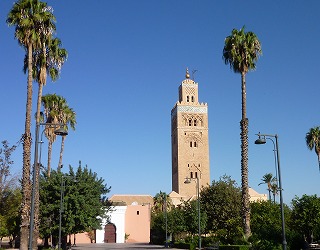 |
|
 This mosque is the Moorish-style architecture with different decorations
on each of the four sides. This mosque is the Moorish-style architecture with different decorations
on each of the four sides.
It originally started construction as a mosque at the beginning of 12th century, but was finally completed in 1192.
No more splendid weather would be hoped! Feeling refreshed, I got closer
to it and looked up at the top.
Three balls are shining in the blue sky. They are said to give happiness
to the square, and according to the guide "the three balls from below
to upper display this world, the next world and the God world."
True, they are the symbol, because they were always shining near and faraway
during anytime anywhere we were sightseeing, and also after getting out
of Medina.
In the past priests went up to the top floor every five times to the adhan
(the call to prayers from a mosque's minaret), but now a loud speaker is
doing it.
This adhan talked out in a special low voice was heard anywhere other than
Marrakech.
|
|
| Tombeaux Saadiens |
|
| The Saadi Dynasty is the dynasty from the middle of 16th to the latter
of 17th century, and this place is called Saadian Tombs where Sultan Mohammed
ash-Sheikh (a king) is buried, who began the reign in 1554 and vanquished
the Wattasids at the Battle of Tadla.
The entrance was limited to one by one, so we had to wait for 30 minutes
to enter. Such inconvenience once contributed to my jolly experience, which
appears in the last chapter "Ala Carte 2".
This tomb complex was divided to 3 rooms. We saw each of them around, but
just had a glimpse of them thinking of the time. Each room must have its
own solemn story.
|
|
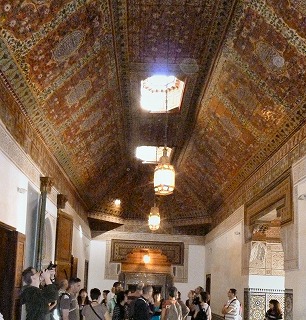 |
|
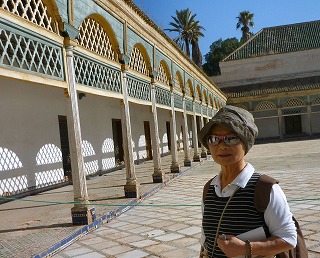 |
|
| Jardin Menara |
|
This garden was made during the age of Almohad Caliphate in 12th century.
There was a detached palace along the broad reservoir. We had a peaceful
view. |
|
 |
|
| Though another picture I certainly took is lost, imagine there is an olive
woods on the right, where we walked. |
|
 |
|
| During seeing the detached palace, the place of kings spent in secret,
I associated it with Bang Pa-In Royal Palace, Thailand, I ever visited
in 2003, suitable or not. |
|
 |
|
| Place Djemaa el Fna |
|
| We visited this square at dusk when began the vigor of full-scale. |
|
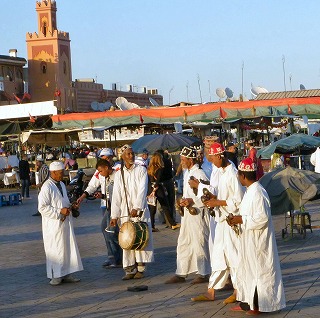 |
|
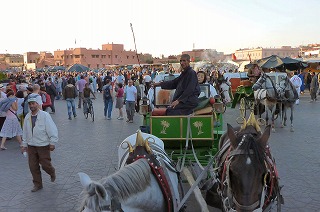 |
|
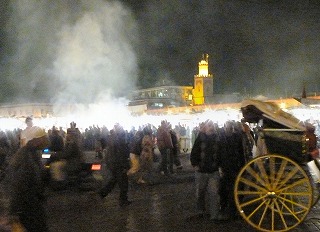 |
|
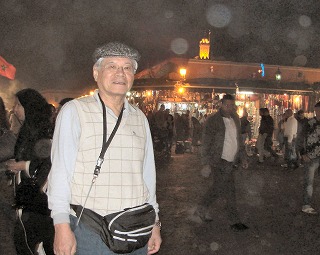 |
|
Street performers are surrounded by a lot of crowds here and there. Loud
sounds of drums peculiar to Moroccan music are ringing out violently.
Every side of the square is lined with stands all over. They do not seem to be only for sightseeing visitors. On the contrary, they may be open for residents as well. I was amazed, thinking this ambience is the World Heritage in casual wear. |
|
We rode in a carriage and saw the sights around the square for 30 minutes.
It was a comfortable ride with a wonderful sound of hoofs. I called out
to local walking people like "Asalaam alaikum", then they, with
no exception, smilingly answered back with the same words waving their
hands. It was amazing that such greetings of smile had power as such.
While feeling the different culture of Morocco on one side, I was convinced
curiously that human beings are most probably be the same after all. |
|
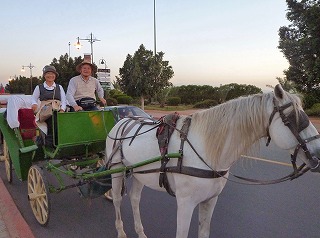 |
|
| Fantasia Show |
|
We arrived at the show around 21:00 and it began at 22:00.
The site was as large as an oblong baseball stadium. We sat on a towal
prepared for the cold on the oblong seat. |
|
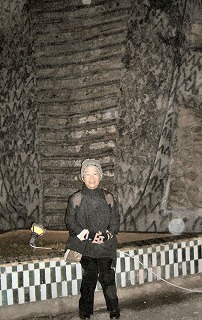 入口 入口 |
|
Following an acrobat and belly dance, a piggyback fight show began.
Though the stars are twinkling in the night sky, the site is dark. More
than 20 cavalries made a brave performance under the dim light of the square
with loud roars of their guns.
We enjoyed the spectacle for 1.5 hours. |
|
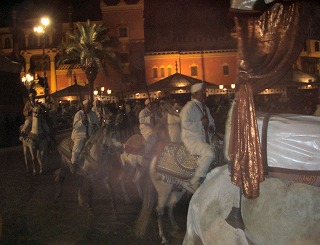 |
|
 |
|
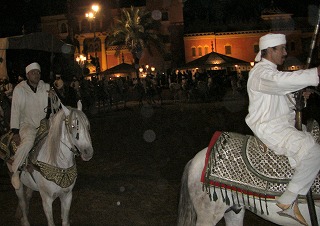 |
|
|
Returned to the hotel in the midnight and went to bed immediately.
Though began listening to the rakugo "kaketori" (a bill collector)
by Katsura Bunji through the iPod, how long did I stick to it?
|
|
| Pictures around Marrakech |
|
Koutoubia Mosque, Bab Abnau, Jardin Menara
Tombeaux Saadiens, Palais de la Bahia |
|
| Place Djemaa el Fna, Fantasia Show |
|
| Other scenic spots |
|
| Reading: 12:10 |
|

